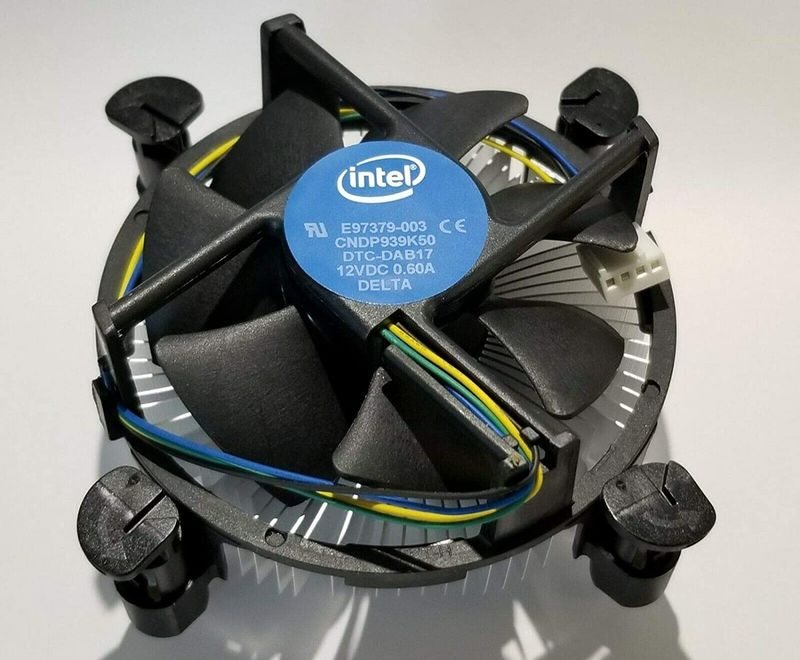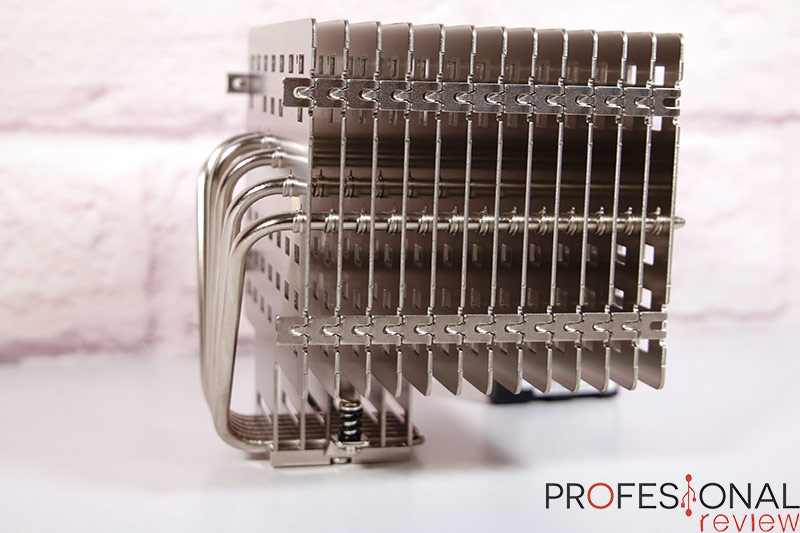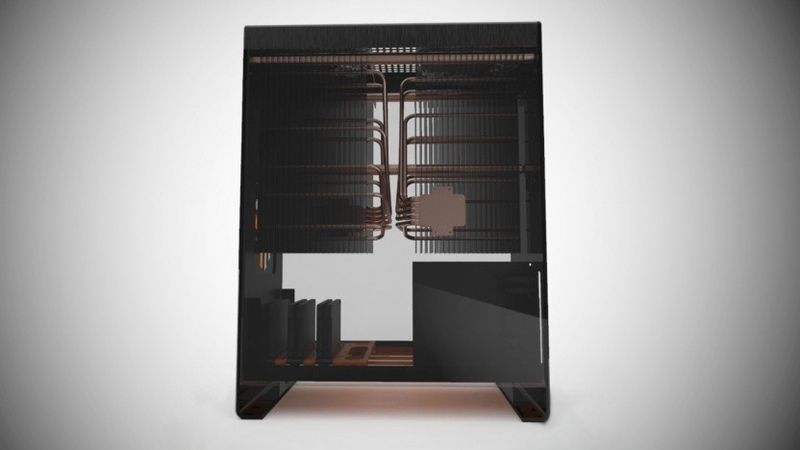Passive heatsink: We can create an ultra-quiet PC
If you are thinking of developing a highly silent computer, know that there are ways to achieve this without sacrificing much performance. We can opt for a passive heatsink to cool our processor, but can we find a passive heatsink for graphics cards?
Index of contents
What is a heatsink?

It is an element that is used to reduce the temperature of electronic components. What a heatsink does is absorb the heat generated, usually by a chip, and try to “eliminate” it.
Heatsinks for processors and graphics cards are based on one or more caleoducts (heat pipes) that pass through a block of aluminum fins. What these aluminum fins do is facilitate the dissipation of heat when being crossed by air currents. Typically CPU and GPU heatsinks add one or more fans to enhance heat dissipation.
We can find heatsinks for passive-type processors on the market. We understand a passive heatsink, for a heatsink for a component that lacks an element that helps dissipate heat, come on, one or more fans.
Most computers are full of these passive heatsinks. The RAM memories, M.2 NVMe SSDs, VRM phases, and the chipset have a passive heatsink to cool the heat. We can find heat sinks in power supplies, specifically to dissipate the heat generated by power transistors. It should be noted that the AMD X570 chipset in its first version had a fan to help dissipate heat.
Characteristics of a passive heatsink
The main characteristic of a passive heatsink is the ability to cool a chip, be it a processor, chipset, GPU, or other components, without the need for fans. The heatsink must have the ability to dissipate the heat generated by the chip with the same air convection, something that may not be easy. Passive heatsinks are usually specially designed with many heat dissipation fins. They also need to be designed to allow efficient passage of air between the fins, which is often difficult.
Also, passive heatsinks can get quite bulky and heavy. It is very difficult to cool a mid-range or high-end processor, but it is even more difficult to cool the GPU of a mid-range or higher graphics card . The higher the TDP of the components, the larger the heatsink must be in order to be able to cool all the heat.

Passive processor heatsink
We can find some passive cooling solutions for processors on the market, but there are very few. Most passive heatsinks are designed for Intel LGA115X sockets and for processors prior to AMD Ryzen. It is quite difficult to find passive heatsinks for the latest generations of processors . Also, there is the TDP restriction, most of the time supporting entry-end processors, at best.
Noctua recently launched the NH-P1 passive heatsink , which is intended directly for next-generation processors. This heatsink is characterized by having a weight close to 1.2 kilograms and is compatible with the Intel LGA1200 and AMD AM4 sockets . Noctua indicates compatibility with all Intel Core Rocket Lake processors (some with limitations) and compatibility with all AMD Ryzen 5000 (some with limitations) except Ryzen 9. If you want to know more about this heatsink, we leave you the review of the Noctua NH-P1 .

Last updated on 2021-09-18
Passive heatsink for graphics card
We have been looking for passive heatsinks for graphics cards, but there are currently none. AMD and NVIDIA GPUs increasingly have a higher TDP and that makes it unfeasible for them to be passively cooled. It would require a huge heatsink, which would add a lot of weight and put the motherboard and the graphics card itself at risk.
Although there are no passive heatsinks for gaming graphics cards, we can find discrete graphics with passive heatsinks on the market. We have the NVIDIA GT 710, GT 730, and GT 1030 that make use of passive heatsinks. These graphics cards are not intended for gaming, they are intended to offer graphics in systems whose processor lacks an iGPU.



Last updated on 2021-09-24
Passive heatsink for M.2 NVMe SSD
In addition to the processor and graphics card, another component that requires cooling is the M.2 NVMe SSD storage drives. This type of unit has a problem and it is that the controller and memory chips get very hot and performance drops. To solve this problem we have a large number of passive heatsinks for M.2 NVMe SSDs on the market that corrects this problem. There are some active heatsinks or liquid cooling mounts, but a passive heatsink is more than enough.
Many M.2 NVMe SSD manufacturers already natively install such heatsinks in their drives. We also find mid-and high-end motherboards that add passive heatsinks for these types of drives for system design consistency.



Last updated on 2021-09-11
Passive chassis-heatsink
We have seen in recent years some quite interesting proposals for those who want a fully passive system. Various computer chassis have been introduced with a built-in heat sink structure to build a totally silent computer. The heatsink is the same chassis in some cases and in other cases it is “perfectly” integrated into the chassis. The solutions of this type that we can find in the market are:
- MonsterLabo The Beast: It is without a doubt the strongest heatsink that we can find on the market today. This system is designed to support mini-ITX and ATX motherboards, which offer a lot of flexibility. It allows to dissipate up to 400W of heat, which is divided into 150W for the processor and 250W for the graphics card. Thus, it supports most of the gaming processors on the market and entry-level graphics cards, even some of the mid-range.
- MonsterLabo The First: The first solution that MonsterLabo developed is a slightly more performance-limited chassis. This chassis only supports mini-ITX type motherboards, thinking more of a compact system. In addition, it supports processors with a maximum TDP of 100W and graphics cards whose maximum TDP is 120W.
- Streacom DB4: We could say the simplest passive heatsink combo chassis that can currently be found on the market. It supports only mini-ITX type motherboards, processors with a maximum TDP of 65W, and graphics cards whose GPU has a maximum TDP of 65W.

The chassis and order, essential for a quiet computer
If you are going to choose to mount a system with a passive heatsink for the processor, you must consider the order and the airflow. This is what you should know to avoid temperature problems when using a passive heatsink:
- Front of the chassis: It is essential that you choose a chassis whose front panel is of the grille type, in order to allow a large air intake. If we choose a closed front, what we will end up having are notable temperature problems due to low airflow.
- Order is critical: Having all cables well organized is important so as not to “disturb” the airflow. We should not leave any liana cables in the middle, since that will reduce the efficiency of the airflow. It may seem like a minor thing, but any interference in the airflow, in this case, can affect a lot.
- Fan: We can find low-speed fans on the market, which are ideal for these cases. These fans allow to increase the flow of air and the noise they generate is minimal. In addition, this will allow a better performance of the heatsink, since the heat dissipation will be greater and the processor will work more “comfortable”.
Final words on passive heatsinks
Having a completely passive system can be difficult and even more so if we want to build a gaming computer. Ideally, we always mount one or two low-speed fans to facilitate air circulation. It is essential for a system with a passive heatsink that the chosen chassis has a front grille type, to facilitate the air intake well. Cable management is also very important to facilitate the airflow of the system.
Here we recommend the best processor heatsinks on the market
Setting up a gaming device and mounting a passive heatsink for the processor is not recommended. If we want to create a multimedia system for the living room that is silent and we are going to mount an AMD Ryzen APU, it is a more than an acceptable option. We will not make intensive use of the system either and thus save the hassle of the fan, which can be heavy in a system for the living room.
Do you have a passive heatsink on your computer or are you thinking of opting for a passive heatsink for your new computer?



